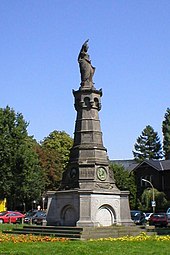Germania War Memorial (Witten)

The Germania war memorial in Witten was ceremoniously unveiled on September 20, 1877. In particular, the Guard Warrior Association founded in 1854, which merged with the Witten Landwehr and Warrior Association in 1858, campaigned for the erection of this monument. On July 3, 1877, the foundation stone was laid on Königsplatz . The monument was designed by the Witten-born architect Heinrich Klutmann , who worked as a high-ranking Prussian construction officer in Berlin . Its construction cost the city of Witten 18,801.97 marks , most of which were raised through collections of voluntary donations. The entrepreneur Louis Berger , who also initiated the erection of the war memorial, donated 100 thalers .
Central location 1877
The city's magistrate chose a plot of land on the edge of the city center as the location. The center of the city of Witten was the so-called Oberdorf with its market square (Kornmarkt) and the Johanniskirche until 1869. In the process of industrialization and the associated influx of many workers from all parts of Germany, the city planners decided in 1866 to create a modern city center to create. This city center was to be closed off by the railway line of the Bergisch-Märkische Eisenbahn , the railway line also represented one side of a square within which the new city center was to be built.
While the station represented a corner point of the line along the railway line, a second corner point in the form of the new Königsplatz was created at the end of this imaginary line. High-quality living space was built around this square - according to contemporary standards. The new quarter should represent a new, modern Witten. In order to underline this concern, the newly built streets were named after great statesmen like Otto von Bismarck and Helmuth von Moltke , in keeping with contemporary custom .
The Königsplatz was lavishly planted, in 1877 the war memorial with the crowning statue of a Germania was finally erected in its center . With this memorial, a victory memorial, the Witteners commemorated the German Wars of Unification ( German-Danish War of 1864, German War of 1866 and Franco-German War of 1870/71). In addition to an elaborate Germania statue, the names of all Witten soldiers who lost their lives in these wars were embedded in the memorial. In addition, four stone allegorical eagles adorned the base of the monument until the end of World War II .
In order to underline its importance in the context of town planning, an enclosure was built around the monument in 1884 , which cost around 4,000 marks.
In addition to the representatively designed apartment buildings , some outstanding villas for their time were built in the square around Königsplatz .
Loss of importance after 1945
At the end of the 19th century, the quarter was considered to be Witten's noble quarter, but this changed in the course of the early 20th century. Although the city planners of the municipal authorities had envisaged that the line between the train station and Königsplatz would develop into a promenade, it was more likely to develop between the train station and the upper village with its market. The Bahnhofstrasse served as the connection between the two points and is now, in a slightly modified form, the city's shopping mile. As early as the 1920s, automobile traffic parallel to the railway line increased massively, so that Königsplatz was now on the edge of a main road, which was not intended.
Many of the villas survived the bombing raids of 1944, but massive new buildings were built around them in the years after the war. The square lost its park character in the following years, it degenerated into a small green area with a monument. The imperial eagles disappeared, parts of the green area even gave way to a parking lot.
The Germania monument was not dismantled, but in order to soften the nationalistic character of the monument, the square was renamed Karl-Marx-Platz. He still bears this name today.
After the war, the fence around the monument also disappeared. After 1945, the war memorial as a relic of an epoch that had long since been overcome was not treated with particular care for decades. In the 1990s in particular, it was smeared with graffiti , the remaining green spaces were trampled down and no longer refreshed, the lower walls of the monument were even badly damaged by urine. The city finally accepted the offer of a cleaning company from Witten to clean the monument free of charge (more or less as self-promotion). During the restoration work, it was found that some memorial plaques were already so badly weathered that the names of the fallen are barely recognizable. After the work, the city created a flower bed around the monument.
The monument is now listed as an architectural monument in the city's list of monuments.
literature
- Ralph Klein: 150 years of urban planning for Witten . 1st edition. Verlag de Noantri, Bremen / Wuppertal 2017, ISBN 978-3-943643-06-0 , p. 33-40 .
- Heinrich Schoppmeyer : Witten. History of the village, town and suburbs . tape 1 . VOHM , Witten 2012, ISBN 978-3-00-040266-1 , p. 367-368 .
- Paul Brandenburg, Karl-Heinz Hildebrand: Witten. Streets, paths, squares . With a contribution to the history of Witten settlement by Heinrich Schoppmeyer (= contributions to the history of the city of Witten . Volume 1 ). VOHM, Witten 1989, ISBN 3-920611-13-6 ( street directory ( Memento from May 15, 2006 in the Internet Archive ) [accessed December 27, 2012]).
- Michael Schenk (Ed.): Witten (= archive images ). Sutton Verlag, Erfurt 2004.
Web links
Coordinates: 51 ° 26 '25.4 " N , 7 ° 19' 49.8" E
